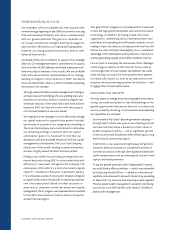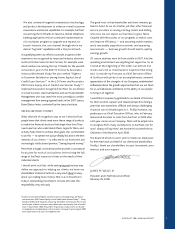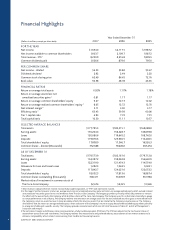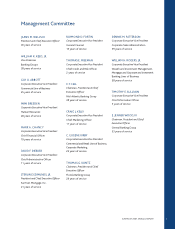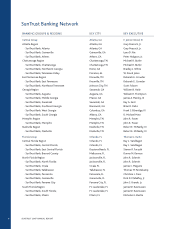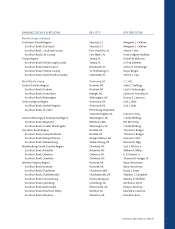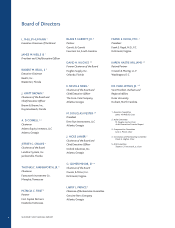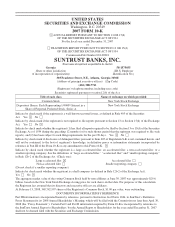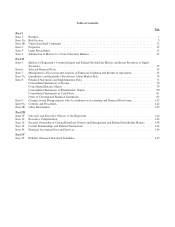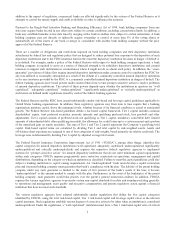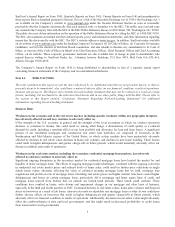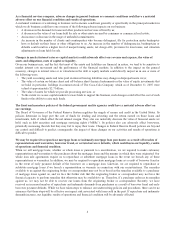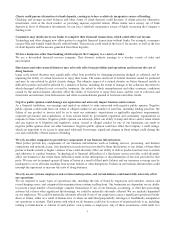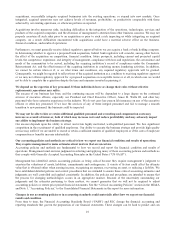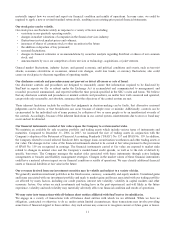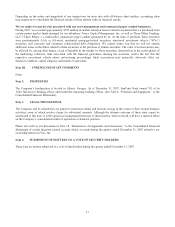SunTrust 2007 Annual Report Download - page 14
Download and view the complete annual report
Please find page 14 of the 2007 SunTrust annual report below. You can navigate through the pages in the report by either clicking on the pages listed below, or by using the keyword search tool below to find specific information within the annual report.addition to the impact of regulation, commercial banks are affected significantly by the actions of the Federal Reserve as it
attempts to control the money supply and credit availability in order to influence the economy.
Pursuant to the Riegle-Neal Interstate Banking and Branching Efficiency Act of 1994, bank holding companies from any
state may acquire banks located in any other state, subject to certain conditions, including concentration limits. In addition, a
bank may establish branches across state lines by merging with a bank in another state, subject to certain restrictions. A bank
holding company may not directly or indirectly acquire ownership or control of more than 5% of the voting shares or
substantially all of the assets of any bank or merge or consolidate with another bank holding company without the prior
approval of the Federal Reserve.
There are a number of obligations and restrictions imposed on bank holding companies and their depository institution
subsidiaries by federal law and regulatory policy that are designed to reduce potential loss exposure to the depositors of such
depository institutions and to the FDIC insurance fund in the event the depository institution becomes in danger of default or
is in default. For example, under a policy of the Federal Reserve with respect to bank holding company operations, a bank
holding company is required to serve as a source of financial strength to its subsidiary depository institutions and commit
resources to support such institutions in circumstances where it might not do so absent such policy. In addition, the “cross-
guarantee” provisions of federal law require insured depository institutions under common control to reimburse the FDIC for
any loss suffered or reasonably anticipated as a result of the default of a commonly controlled insured depository institution
or for any assistance provided by the FDIC to a commonly controlled insured depository institution in danger of default. The
federal banking agencies have broad powers under current federal law to take prompt corrective action to resolve problems
of insured depository institutions. The extent of these powers depends upon whether the institutions in question are “well
capitalized,” “adequately capitalized,” “undercapitalized,” “significantly undercapitalized” or “critically undercapitalized” as
such terms are defined under regulations issued by each of the federal banking agencies.
The Federal Reserve and the FDIC have issued substantially similar risk-based and leverage capital guidelines applicable to
United States banking organizations. In addition, these regulatory agencies may from time to time require that a banking
organization maintain capital above the minimum levels, whether because of its financial condition or actual or anticipated
growth. The Federal Reserve risk-based guidelines define a tier-based capital framework. Tier 1 capital includes common
shareholders’ equity, trust preferred securities, minority interests and qualifying preferred stock, less goodwill and other
adjustments. Tier 2 capital consists of preferred stock not qualifying as Tier 1 capital, mandatory convertible debt, limited
amounts of subordinated debt, other qualifying term debt, the allowance for credit losses up to a certain amount and a portion
of the unrealized gain on equity securities. The sum of Tier 1 and Tier 2 capital represents the Company’s qualifying total
capital. Risk-based capital ratios are calculated by dividing Tier 1 and total capital by risk-weighted assets. Assets and
off-balance sheet exposures are assigned to one of four categories of risk-weights, based primarily on relative credit risk. The
leverage ratio is determined by dividing Tier 1 capital by adjusted average total assets.
The Federal Deposit Insurance Corporation Improvement Act of 1991 (“FDICIA”), among other things, identifies five
capital categories for insured depository institutions (well capitalized, adequately capitalized, undercapitalized, significantly
undercapitalized and critically undercapitalized) and requires the respective federal regulatory agencies to implement
systems for “prompt corrective action” for insured depository institutions that do not meet minimum capital requirements
within such categories. FDICIA imposes progressively more restrictive constraints on operations, management and capital
distributions, depending on the category in which an institution is classified. Failure to meet the capital guidelines could also
subject a banking institution to capital raising requirements. An “undercapitalized” bank must develop a capital restoration
plan and its parent holding company must guarantee that bank’s compliance with the plan. The liability of the parent holding
company under any such guarantee is limited to the lesser of five percent of the bank’s assets at the time it became
“undercapitalized” or the amount needed to comply with the plan. Furthermore, in the event of the bankruptcy of the parent
holding company, such guarantee would take priority over the parent’s general unsecured creditors. In addition, FDICIA
requires the various regulatory agencies to prescribe certain non-capital standards for safety and soundness relating generally
to operations and management, asset quality and executive compensation and permits regulatory action against a financial
institution that does not meet such standards.
The various regulatory agencies have adopted substantially similar regulations that define the five capital categories
identified by FDICIA, using the total risk-based capital, Tier 1 risk-based capital and leverage capital ratios as the relevant
capital measures. Such regulations establish various degrees of corrective action to be taken when an institution is considered
undercapitalized. Under the regulations, a “well capitalized” institution must have a Tier 1 risk-based capital ratio of at least
2


